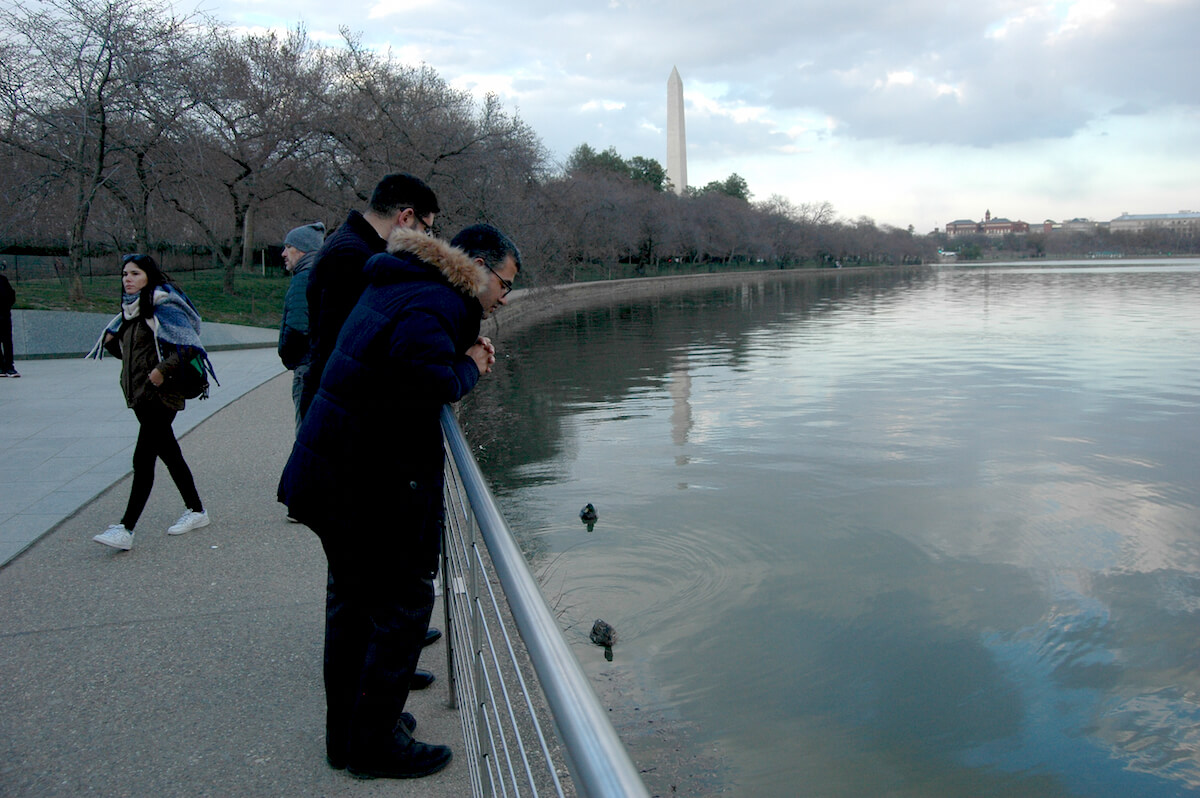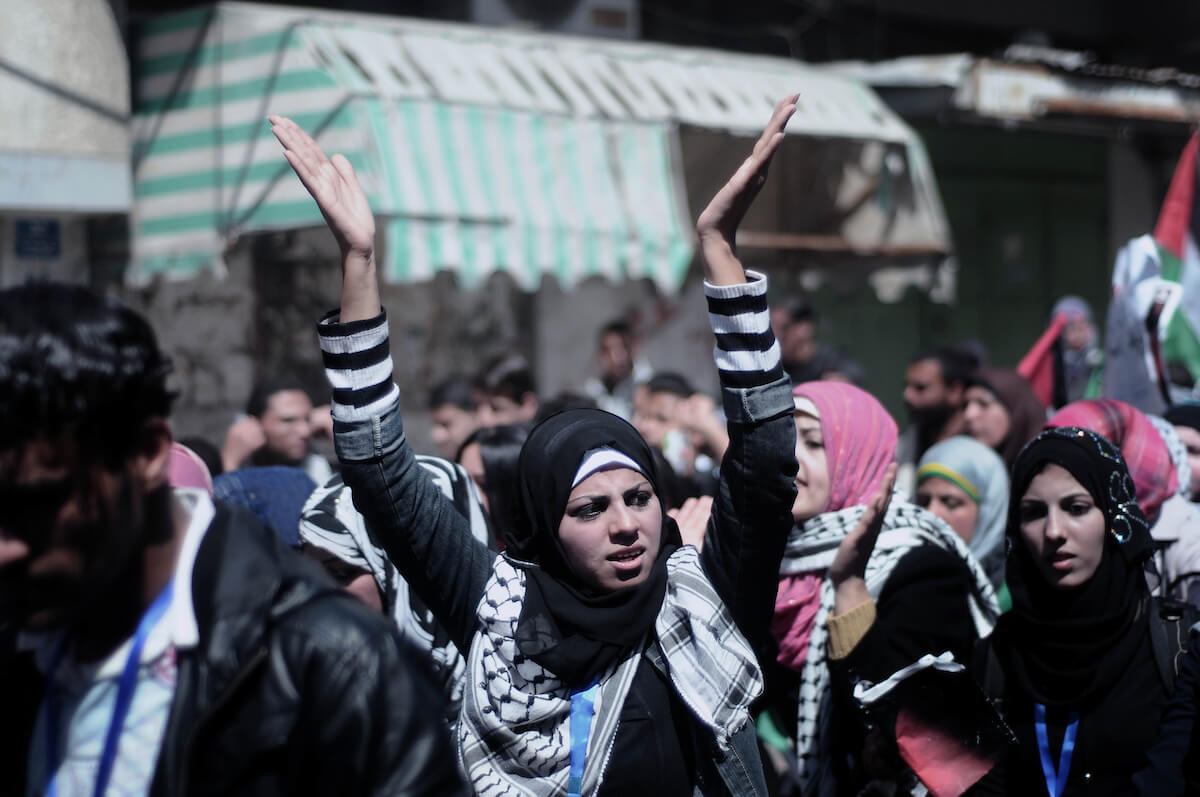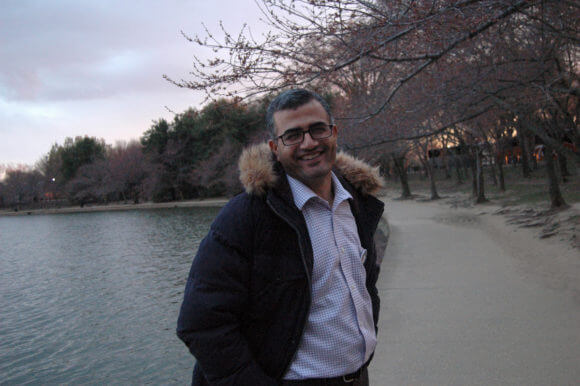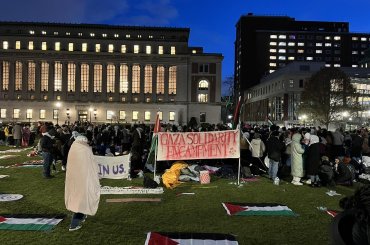It all started because of a bird. Ahmed Abu Artema, the unlikely leader of the largest popular Palestinian movement in decades, strode beside the separation fence that divides his home in the Gaza Strip from Israel on a January evening last year. At twilight he saw birds fly overhead, soaring past the fence “and no one stopped them.”
It was a moment of definitive clarity. Ahmed was physically stuck inside a besieged non-state territory, and here was a flock birds more free than him.
“Why do we complicate simple matters? Isn’t it the right of a person to move free like a bird?” he asked. Looking again at the fence, frustrated he thought, “It clips my wings,” “it kills my dreams” and “it disrupts my evening walks.”
“What if one of us”—Palestinians from Gaza—“sees himself as a bird and decides to reach a tree beyond the fence?” Ahmed suspected, “If that bird was Palestinian he would be shot.”
Later that night Ahmed posted to Facebook a message that went viral asking Palestinians to march towards the fence with the goal of camping a few miles beyond the barrier, a veritable right of return for Palestinian refugees who could no longer wait on a solution from a moribund peace process. A few months later on March 30, 2018, the Palestinian holiday of Land Day typically observed by demonstrations, marked the start of Ahmed’s vision.
Dubbed the Great March of Return the protests have continued every Friday since, sometimes with tens of thousands in participating. Intermittently over recent months a small group of Israelis have joined them on the other side of the buffer zone.
“The idea spread so much that it became a social movement in the Gaza Strip,” Ahmed told me on a walk touring Washington DC’s monuments on a cool spring evening this week. He wore a button of the Palestinian flag pinned to his dress shirt. Earlier in the day he spoke at the Carnegie Endowment for International Peace as part of a three-week tour organized by the American Friends Service Committee. His comments here are taken from both the formal briefing and the conversation with me that followed.
At 34 he is a bespectacled, soft-spoken yet methodical, father of four children under the age of eight, with strewn gray hairs. He has been in the U.S. for nearly two months and is still amazed by some of the facets of life outside of the siege that Gaza has endured for the last decade. The sounds of airplanes in particular. “When you hear a plane, it’s a symbol of life, but in Gaza it’s a symbol for death,” he said.
Ahmed traveled internationally only once before, a short trip to Egypt. This is his first journey anywhere during adulthood, and the first occasion where he has been away from the Friday protests.
“I wrote it as a dream, then I went to sleep,” he said, “It’s not my individual power that made the idea spread.”

There is no international border that demarcates Gaza. It is hemmed in by an armistice line from the 1948 Arab-Israeli war, reinforced after the June 1967 war. A buffer zone stretches along the eastern edge, at its widest about a kilometer deep. From inside of Gaza the barbed wire and chain links are visible from the main highway that in any other context would be called a country road. Salah ad-Din Street, named for the founder of the Ayyubid Caliphate, which ushered in a period of economic prosperity across much of the Middle East, can be driven in its entirety in a mere 30 minutes, without speeding.
On this street, “If you look to your right you can see the barbed wire fence,” Ahmed said, and to his left, an Israeli naval fleet in the Mediterranean Sea.
“Imagine being confined by that much space,” and at the moment time surrounded by Gaza’s 2.2 million residents, of whom two-thirds are refugees and their heirs originally from lands inside of Israel, Ahmed added.
Functionally, Gaza it is a protracted non-state, a near historical aberration where an enclave of the Ottoman Empire and later a British mandate never gained independence as a Palestinian state during de-colonization across the Middle East that followed World War II. Statehood was promised during the Oslo Peace Accords, but has yet to be realized. By the terms of international law it is the western portion of the fragmented occupied Palestinian territory. Yet to its oldest residents the Strip has been under a maelstrom of foreign powers with no end in sight. An octogenarian Palestinian has lived under British, Jordanian, and now Israeli control. Though Israeli settlers and soldiers evacuated from inside of Gaza in the 2005 disengagement that came from a past peace accord, Israel still controls all but one of the checkpoints in and out of Gaza and has jurisdiction over the air and sea.
Over the last decade and a half Gaza has been governed by the Islamic movement Hamas. In that time Gaza has not only been geographically disconnected from the West Bank, but increasingly politically isolated from Ramallah after the government split in two in 2006, a few months before Israel’s siege began and a year after the last time Palestinian elections were held outside of municipal races. Since then, the West Bank-based Palestinian Authority has negotiated peace talks with Israel brokered by the U.S. vis-a-vis forays from John Kerry and now President Donald Trump, with the fate of Gaza often sidelined.
Once Trump declared Jerusalem as Israel’s capital last year, Ahmed said it was a game changer for his friends and him. At that point he did not know anyone who saw the U.S. an an impartial broker to a peace process. “We know that historically the American administrations were closer to Israel, of course,” Ahmed said, “Our experience didn’t leave a place for us to trust the U.S. administration, but Trump was a more extreme example.”
Trump, Ahmed said, was the reason Palestinians felt pushed to the edge. Protesting near the fence with Israel was widely regarded as risky. “He sparked the fire with his policies that bias Israel. People felt their basic rights are in danger.”
The United Nations reported Israeli forces have killed 260 Palestinians in the demonstrations that began last March, and have injured more than 26,000, nearly 7,000 of whom were struck with live bullets. Palestinians have killed two Israeli soldiers, and injured four during protests by the fence.

In the past Ahmed attempted to organize a non-violent movement in Gaza that would breach the barricades with Israel. The closest he came was helping organize a demonstration in May 2011 where Palestinian refugees in Lebanon and Syria amassed on the borders with Israel by the thousands with dozens entering Israel. The Guardian reported at the time Israeli forces killed 13 on the northern front and wounded 60 in Gaza with live-fire. Concurrently, dramatic shifts were taking place across the region.
“When the Arab Spring started especially after [Egypt’s] Hosni Mubark fell, we felt inspired,” Ahmed said.
Indeed, while an uprising was unfolding in Tahrir Square, tucked in cafes in Gaza and Ramallah disaffected youth like Ahmed attempted a Palestinian revolution of sorts. The March 15 Coalition, sometimes called Hirak Shababi, galvanized young Palestinians in the West Bank and Gaza in demands for reconciliation between the West Bank-based Fatah and Hamas-led Gaza. It was the first Palestinian social movement in the age of Twitter, and the first sustained activism that targeted their own leadership. But the dissidence was short-lived and marred by internal divisions and brutal crackdowns. After two years the new youth movement had fizzled out.
“They were politically limiting,” he said of the past protests, “there was no definition about political divisions and what was the root cause.”
“Hamas said they are against division, Fatah said they are against division. What’s the point when everyone says it?” To Ahmed, his ambition needed plain language: “We want to return to our homes and we are refugees.”
Ahmed is well aware that large areas where Palestinian villages once stood in Israel and were destroyed during the 1948 war were never developed. Activists from the Israeli group Zochrot, and urban planners from the Palestinian organization Badil have floated the possibility of using Israel’s rolling nature reserves as the site for Palestinian resettlement. Yet there is little support for this notion in Israel outside of a few hundred on the far-left, and the cause has never been taken up by any political party, including Arab parties in Israel.
A past peace negotiation between Israel’s former Prime Minister Ehud Olmert and the Palestinian President Mahmoud Abbas reportedly fell apart, in part, over the number of Palestinians who would be allowed to return to Israel. Olmert agreed to 5,000, and President George W. Bush who was overseeing the talks offered to give 100,000 U.S. citizenship in the context of a two-state solution. For Palestinians these numbers are regarded as offensively low. The Palestinian refugees number more than 7 million.
“If the world had the will it would be able to put an end to the tragedy of those refugees,” Ahmed said, “we want a solution based on the foundation of justice, equality and humanity,” to “coexist with their Jewish neighbors according to the values of citizenship.”
“While the Jewish people have a right to live in peace and security, it’s not fair to solve a tragedy by creating another one,” he said.
Part of that unfairness, as Ahmed saw it, is because life in Gaza has turned, fast. Most homes have electricity for just six hours a day with outages lasting up to 16 hours. The healthcare system is crumbling. Trump administration cuts to refugee services have caused clinics to shutter. Serious illness cannot be treated locally and permits to exit for care in an Israeli, Egyptian or other hospitals are increasingly hard to come by.
Ahmed stopped taking his children to swim in the ocean three years ago because pollution is so heavy and it has been linked to death. Now on hot summer days they still go to the beach, but the family stands on the sand. When Israeli jets pass over Gaza’s airspace, a sound he describes as frequent, it terrifies his son, “Abdelrahman is very afraid every time he hears a plane.”
“I knew a lot of children who died who were his age, but I haven’t told him about that,” Ahmed said.
“This is one of the motivations for me to be an activist. I try, not only me, but we try to create a better world for our children,” he said, “I can’t imagine the life my father lived, that I lived, for them.”
Infrastructure breakdowns started in earnest about ten years ago when the UN warned Gaza would become “uninhabitable” by 2020. The report was published in response to worsening conditions around the blockade, but Ahmed contends a “complete economic collapse has already happened” one year ahead of deadline, “rendering Gaza a complete wasteland.”
“Would you accept a life like this, or would you demand better?” he asked.
“If you were a young person in Gaza, you may turn 35 without ever getting a job,” he described, “to be a father in Gaza means you feel ashamed because you cannot provide food for your family.”
With Gaza becoming uninhabitable compounded by the Trump-factor, Ahmed had an eager audience looking for new options. The time was ripe to try non-violence on a broad scale in Gaza.

In his original post on Facebook back in January 2018 he called for peaceful tactics.
“What if 200,000 demonstrators accompanied by international media marched peacefully and breached the barbwire fence east of Gaza to enter a few kilometers of our occupied land, carry Palestinian flags and keys of return?” Ahmed wrote, “What if tens of thousands of Palestinians built a tent village inside of Israel “and insisted on peacefully remaining there without resorting to any form of violence?*
A majority of the demonstrators have abided by the insistence for peaceful protests, yet many have thrown rocks, lobbed burning tires or released incendiary kites that have burned acres of Israeli farmland. Israeli forces have shot at demonstrators with live-fire and tear gas, the kites are now being intercepted by drones. The scenes are sometimes chaotic and Ahmed finds out about casualties only as a Friday demonstration winds down and he has a moment to check news reports.
Israel has maintained it has a right to use lethal force to defend its borders. Responding to a recent human rights report published by the UN, a spokesperson for Israeli’s Ministry of Foreign Affairs, Emmanuel Nahshon claimed the protests are staged by Hamas. He told the Christian Broadcasting Network, “Hamas exploits the civilians in Gaza as human shields for terrorists.”
Ahmed is aware his longstanding commitment to non-violence is not shared by all protesters, Hamas included. Officials in Gaza have routinely endorsed his movement. Ahmed sees their support as bending to the impulse of those who practice non-violence, not the other way around.
“Our demands were simple and honorable, we want to return, we want a dignified life. Even those engaged in armed resistance started to understand how effective peaceful nonviolence can be,” he said.
“There are people in the Gaza Strip who oppose Hamas, and there’s a context that surrounds the current protest in the Gaza Strip and this includes the hard realities that many people live,” he said, “and many mistakes that Hamas made in the administration of the Gaza Strip.”
“But I would like to raise all of these disagreements that people have with Hamas focus on administration and governance. Those disagreements are not about the occupation,” he said.
*Ahmed Abu Artema’s initial call for the Great March of Return was posted to Facebook on January 7, 2018. The text was translated to English by Jehad Abusalim in the Journal of Palestine Studies, Vol. 47 No. 4, Summer 2018.




RE: “In the past Ahmed attempted to organize a non-violent movement in Gaza that would breach the barricades with Israel. The closest he came was helping organize a demonstration in May 2011 where Palestinian refugees in Lebanon and Syria amassed on the borders with Israel by the thousands with dozens entering Israel.” ~ Deger
SEE: “Netanyahu: Stupid Like a Fox?” | By Uri Avnery | Antiwar.com | June 13, 2011
SOURCE – http://original.antiwar.com/avnery/2011/06/12/netanyahu-stupid-like-a-fox/
Interesting the Arab Spring inspired Palestinians to work toward leadership that worked together (something Israel had long worked to prevent). Then, divisions between activists along with leadership crackdowns ended that essential and necessary path forward. In its place came the questionable plan for a tent encampment in Israel.
I’m wondering if Trump’s plan is to succeed where previous Presidents failed. Carter tried but was denied a second term for trying. Reagan tried and Begin told him he wouldn’t even discuss the plan. Herbert Walker tried and many think that cost him a second term. Clinton kissed up all those years and spent his final day in office trying to parlay that to advantage at Taba. W even tried a little toward the end. Obama started off determined then Netanyahu made him an adversary Israel could refuse to deal with.
Perhaps Trump reasoned he would need political capital to move Israel to a deal both sides would find off-putting. After he moved the embassy he sought to have Palestinians understand he wasn’t determining sovereignty or borders in Jerusalem, that good things would go Palestinians way, perhaps even a Capital in East Jerusalem. It wasn’t surprising Trump would up the ante and refuse a subsidy when relations were cut. Its also not surprising Trump will have to keep kissing Netanyahu’s rear to protect his political leverage until his deal gets put on the table.
That Trump’s embassy move was a game changer because it destroyed “trust” indicates a lack of understanding. America is a system of competing interests where even teachers, farmers or kids can lose if they depend on trust. Israel doesn’t trust America, it takes from it using public relations, persuasions, and media manipulations.
In America, arson and throwing things cancel out peaceful demonstrators. Winning hearts and minds is not so complicated. A majority of Americans will get behind the concept of equal civil and human rights once placards replace stones.
So how many US states have anti-BDS laws economically punishing those who support this non-violent protest movement? Half? 77 US senators voted these laws were OK. The ACLU says they violate the First Amendment. How long before a case raising this issue gets to SCOTUS? Will it be turned down based on no standing, based on political question doctrine? In my understanding of US constitutional law, SCOTUS will have to take the case.
“Ahmed is aware his longstanding commitment to non-violence is not shared by all…” Oh, this sounds like an admission that maybe the “non-violent” demonstrations were not necessarily so non-violent.
Anyway, I would humbly suggest that a new ploy be adopted in order to advance the cause of the Palestinian people. I think that it’s more than obvious that the “Great March of Return” has been a terrible failure. There has to be a better idea for demonstrating. How about taking the masses, giving them signs calling for an end of conflict with the Jews – and then surrounding the office of Mr Sinwar in Gaza, demanding that he declare his willingness to negotiate an end of conflict with Israel. I know that my thinking is revolutionary, but there should be a precedent in history in which problems were solved with the end of conflict (in the midst of conflict it’s a bit more tricky to arrive at understandings). The demand for the right of return (without even hinting that this would be the end of conflict) is simply a waste of time. No one is going to take it seriously. Actually, it would be nice to hear what exactly is the full list of grievances, and it would be incredibly pleasant to hear that rectifying such grievances would mean that the conflict is over.
Probably there will be someone who will answer that Hamas published a new charter in which they “agreed” to a state in the West Bank and Gaza. Well, the new charter also calls for the liberation of Palestine from the Jordan River to the Mediterranean Sea. In short, for those who find this to be a strange contradiction, Hamas agrees that the next step be the two-state “solution”, but the struggle goes on until all of the country is “liberated” from the Jews. Not too surprisingly, no one takes it too seriously. Or someone else will answer that the Arab League peace proposal defines an end of conflict. Well, no, it doesn’t. According to the “proposal”, the Israelis and the Palestinians must reach an agreement on the refugee issue. In other words, instead of proposing a solution that both sides could accept (i.e. a peace proposal), the “peace proposal” proposes that there be negotiations. Speaking of strange contradictions, the Palestinians support the Arab League peace initiative, but they won’t negotiate with Israel.
Why is it that no one in the anti-Israel planet is willing to say that rectifying grievances “x”, “y” and “z” would mean that they would end the struggle against Israel and live with her in peace? Well, actually, it’s quite simple. The intention is to defeat Israel, not to live with her in peace. So, the ploy is to try and make some achievements while not declaring an end of conflict. However, the ploy is not working.
@Nathan
“The intention is to defeat Israel, not to live with her in peace. So, the ploy is to try and make some achievements while not declaring an end of conflict. However, the ploy is not working”
There is no need for the Palestinians to “defeat” Israel. Israel is doing a great job of defeating itself. Sooner rather than later the US sponsored Zionist “peace plan” of endless negotiations about negotiations about a 2SS will melt into history and it will be all about the demographics baby. One Jewish controlled/occupied transparently Apartheid state between the river and the sea with around 50 % of the native inhabitants disenfranchised terrorised brutalised and ghettoised. And then it is simply a question of time before the monstrosity implodes and with the Brooklynites et al jumping ship the native quotient rises well above the 50% . Even the Hebron Fascist settlers will be scrambling to get back to their countries of origin.
Zios never had any real 2SS plan”A” in terms of sharing the land with the native Palestinians. It was from the beginning all about cleansing the “Promised Land” through massacre,ethnic cleansing and terror.
The default Plan “B” which is on the horizon will be an Apartheid South Africa Mark 2 with Bantustans , Jews only this that and the other. It took a while for the Mark 1 to collapse but that was before the Internet,Social Media platforms and live news streaming.
Tick tick